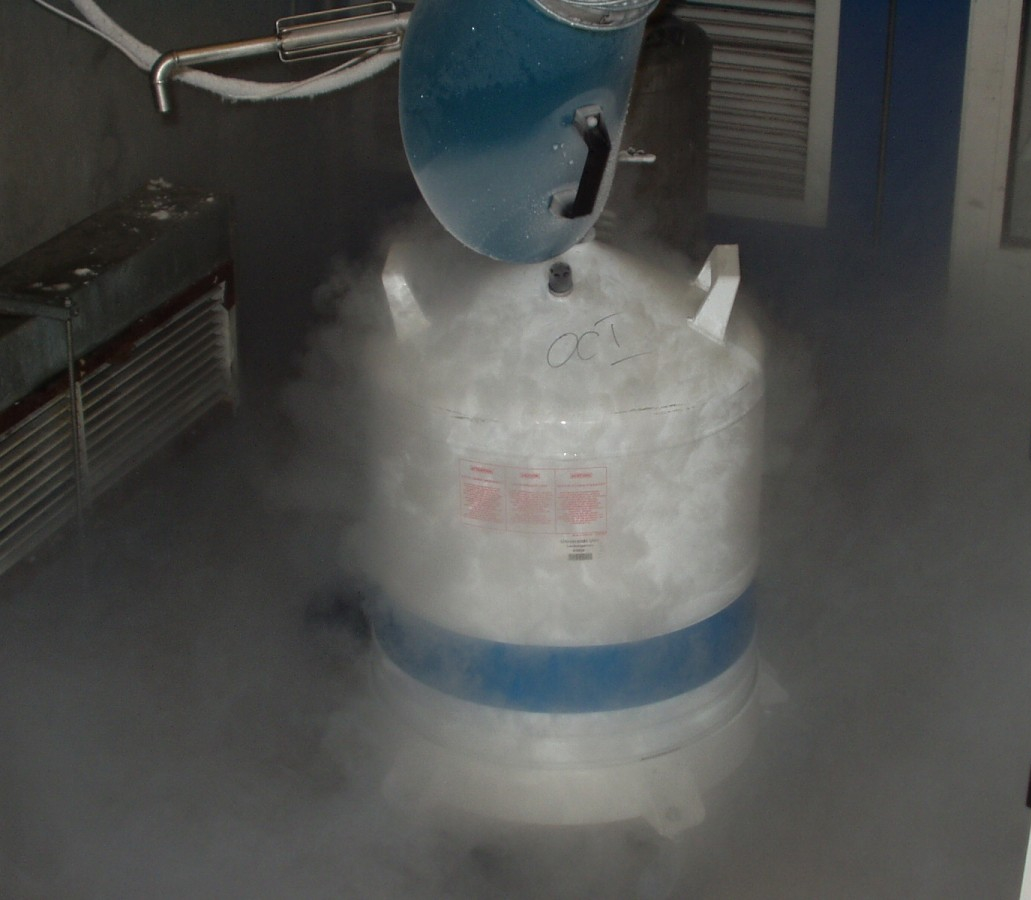Will the future be embodied?

Satan’s deceptions have been around from just after the beginning of time until now, and undoubtedly they will continue to be present until he faces eternal punishment in the lake of fire (Revelation 20:10). Appearing to Eve in the garden of Eden, in bodily form as a serpent, the devil enticed her: “You will not surely die” and, “you will be like God, knowing good and evil.” These temptations still resonate with humans today as they did back in Eden (Genesis 3:4–5).
Of course, Christians do indeed grow in the “knowledge of God” (e.g. Colossians 1:10; 2 Corinthians 4:6) and will ultimately experience eternal life as part of God’s promises. But there are people out there who want to accomplish these things in their own strength ahead of time, apart from God.
Cryonics – perpetuating the body?
One method people choose, attempting to avoid permanent physical death, is cryonics: they hope to be revived again at some point in the future.
This is not futuristic science fiction; people have entertained the idea of freezing human beings from the early 1960s.1 Companies exist and practice the cryonics part right now (e.g. Alcor with 190 patients, as of 14 April 2022). What is yet to be seen is whether their clients will ever be successfully revived. This is an impossibility from a Christian standpoint (see below) but is also science fiction.2 Tellingly, Cryonics Institute (219 patients, as of 30 January 2022) states on their website, “We believe that revival is a real possibility” and that belief is reinforced by hopeful statements like, “increasingly point to a future technology” and, “we might be able to revive people in a healthy and youthful state when these technologies mature”.

The Cryonics Institute claims past successes on some frozen animals (more on this below),3 organs, and even human embryos, but they confess they cannot warrant success for their clients. However, they can guarantee that, “if you don’t sign up for cryonics […] you will have no chance at all of being revived in the future”! Interestingly, however, shortly afterwards they try to reassure potential clients that cryonics is not inconsistent with Christian beliefs (a faith that instructs its followers to “rejoice that [their] names are written in heaven”; Luke 10:20), and are quick to point out that “Cryonics is a form of life support, not resurrection”.4 They cannot fool God. He is the author of life (Acts 3:15): He gives, and takes away (Job 1:21). God determines everyone’s allotted time upon Earth (Psalm 139:16) and their end, after which they will be judged (Hebrews 9:27); and there is no second chance from that point.
Varying definitions of death exist, and some say death is not an on-off switch, but rather a process.5 Typically, establishing legal death (thus permitting a client to start the cryonics process) is presently defined when cardiac arrest occurs—and even here there is no consensus.6
A cryonics team would need to be standing by to pause the onset of decay (autolysis), by taking immediate action, with one of the first tasks being to cool the entire body. This is quite different from the approach taken in the Hollywood blockbuster Jurassic Park, where scientists ‘resurrected’ live dinosaurs; DNA was extracted from trapped mosquitoes in amber, whose last meal—supposedly 65 million years prior—was dinosaur blood. That gave rise to a live dinosaur theme park.
In 1988, some scientists were proactive with the critically endangered black-footed ferret (Mustela nigripes), specifically a female named Willa. However, this conservation effort was nothing like cryonics (where the whole body will be revived). Instead, in 2020, they isolated genetic material from Willa’s preserved skin cells (she had died three decades earlier), and injected this into an enucleated ferret egg cell.7 The resulting zygote was implanted into the uterus of a domestic ferret, and born later as Elizabeth Ann—a clone of Willa. Note that, although the genetic material was over 30 years old, the body of Elizabeth Ann—with all its organs and systems—was a new body.
Decay
Let’s assume, for the sake of argument, that the cryonics process could one day perfectly preserve the current state of the bodily components—‘hardware’ such as lungs, liver, kidneys, heart, brain, and all the rest of the organs and tissues. The body simply could not be as vital as, say, a 25-year-old’s (unless of course the deceased person is 25 years old). Despite the human body’s natural repair systems, on the whole we are on a downhill slope with respect to declining health and debilitation. This bodily deterioration is termed senescence, and many of us have the aches, pains, visible age indicators, and scars that attest to this.
Looking at the information (‘software’) aspect, the genome itself has an enormously sophisticated repair mechanism in place.8 This is no superfluous luxury, with mutations happening in somatic cells at a rate that would very soon be catastrophic, if not kept in check.9 Nonetheless, our DNA also has a finite life. This is determined by the fact that, in virtually all of the body’s tissues, chromosome end-caps (called telomeres) get shorter each and every time the cells divide (discussed here).
Storing the body at -196°C or thereabouts will effectively arrest decay. However, it will not reverse any damage done whilst alive.
AI and the bodiless mind

Many believe that people have souls, but strictly speaking that is wrongly put. Biblically, the whole person is often termed a soul (e.g. Acts 2:41, 43), but the soul is also referred to as the immaterial aspect of our being—see Memory, the brain, and the soul. People have bodies, but the soul is everlasting. Some think the soul is equivalent to the brain. Sharon Dirckx explores this in her book Am I just my brain?10 The body, including the brain, is a collection of hardware. However, you can have all the parts in the correct place (seconds after the brain-stem ceases to function) but it would still not be considered alive.11 Without a running ’operating system’ (in the brain), the body’s hardware simply will do naught.
How about an operating system devoid of a body? Any operating system still needs some sort of medium to exist on/dwell in, although the information is not integral to the medium. Quite a few have considered the idea of continuing worldly life after physical death. They contemplate the esoteric idea of being alive as a software, an intelligence, that continues to live whilst residing on the internet or an artificial body. Max Tegmark explores this in his book Life 3.0:
“… an upload [of our minds] can live in a virtual reality or be embodied in a robot capable of walking, flying, swimming, space-faring or anything else allowed by the laws of physics, unencumbered by such everyday concerns as death or limited cognitive resources.”12
Even if, for the sake of the argument, one granted consciousness to such an entity, it would not be alive in the biblical sense (a person, ‘he’ or ‘she’, made in the image of God). The virtual reality version of a human wouldn’t have any senses (sight, hearing, touch, smell, and taste), and even an embodied (robot) specimen with various sensors could not be morally aware. What moral laws would be coded? In stark contrast, the Lord declared: “I will put my laws on their hearts, and write them on their minds” (Hebrews 10:16).
Concluding remarks
This short article has only scratched the surface of the topic. What we can say is that the desire to postpone or escape death (through cryonics or any other means) is incompatible with true Christian faith. For all people of the past (with two exceptions, Enoch and Elijah), the present, and those yet to live in the future, death is an unavoidable reality (Hebrews 9:27); with the exception of those alive at the time of Jesus’ return (see 1 Thessalonians 4:15).
Those in Christ will one day be resurrected and will be given new eternal bodies (see 1 Corinthians 15:42–44; 2 Corinthians 5:1–10). Those who rebel against God and reject His abundant life (John 10:10) shall be “thrown into hell, where their worm does not die and the fire is not quenched” (Mark 9:47–48, quoting from Isaiah 66:24).
Rather than our old body being possibly revived at some future date, or perhaps existing as a bodiless web-based entity, there is a more straightforward, glorious, and guaranteed answer to the question, “what shall I do to inherit eternal life?” (Luke 10:25):
You shall love the Lord your God with all your heart and with all your soul and with all your strength and with all your mind, and your neighbor as yourself. […] do this, and you will live (Luke 10:27–28).
References and notes
- Cryonics was first proposed by Robert Ettinger in The Prospect of Immortality; see Devlin, H., The cryonics dilemma: will deep-frozen bodies be fit for the new life? The Guardian, 18 Nov 2016. Return to text.
- Wieland, C., Cryonics, the soul and immortality, creation.com/cryonics-soul-immortality, 13 Feb 2013. Return to text.
- For it to be comparable to humans, it would need to be a vertebrate animal. Some amphibians and reptiles have a freeze tolerance, but it is not at extremely low—cryogenic—temperatures. Rather, they do this in natural environment and not all their body is frozen (although up to 70% of their water content is). See: Storey, K. and Storey, J., Molecular physiology of freeze tolerance in vertebrates, Physiol. Rev. 97:623–665, 8 Feb 2017 | doi:10.1152/physrev.00016.2016. Return to text.
- Cryonics Institute, Frequently asked questions, cryonics.org; accessed 8 Feb 2022. Return to text.
- John Bunyan referred to the great river to be crossed at the end of one’s life in The Pilgrim’s Progress (1678). Return to text.
- Cryonics Institute describes legal death as “when the doctor gives up”. Death has to be ascertained by a professional who will see if the eye-pupils dilate, and check for corneal and gag reflexes (among other things). Return to text.
- Sparks, H., The black-footed ferret project, reviverestore.org, 18 Feb 2021. Return to text.
- Williams, A., Human genome decay and the origin of life, J. Creation 28(1):91–97, April 2014. Return to text.
- Batten, D., DNA repair mechanisms ‘shout’ creation, Creation 38(2):56, April 2016; creation.com/dna-repair-shouts. Return to text.
- Dirckx, S., Am I just my brain? The Good Book Company, UK, 2019. Return to text.
- Academy of Medical Royal Colleges, A code of practice for the diagnosis and confirmation of death, aomrc.org, 2008. Return to text.
- Tegmark, M., Life 3.0: Being human in the age of artificial intelligence, Penguin Random House, UK, p. 155, 2017. Return to text.






Readers’ comments
Comments are automatically closed 14 days after publication.